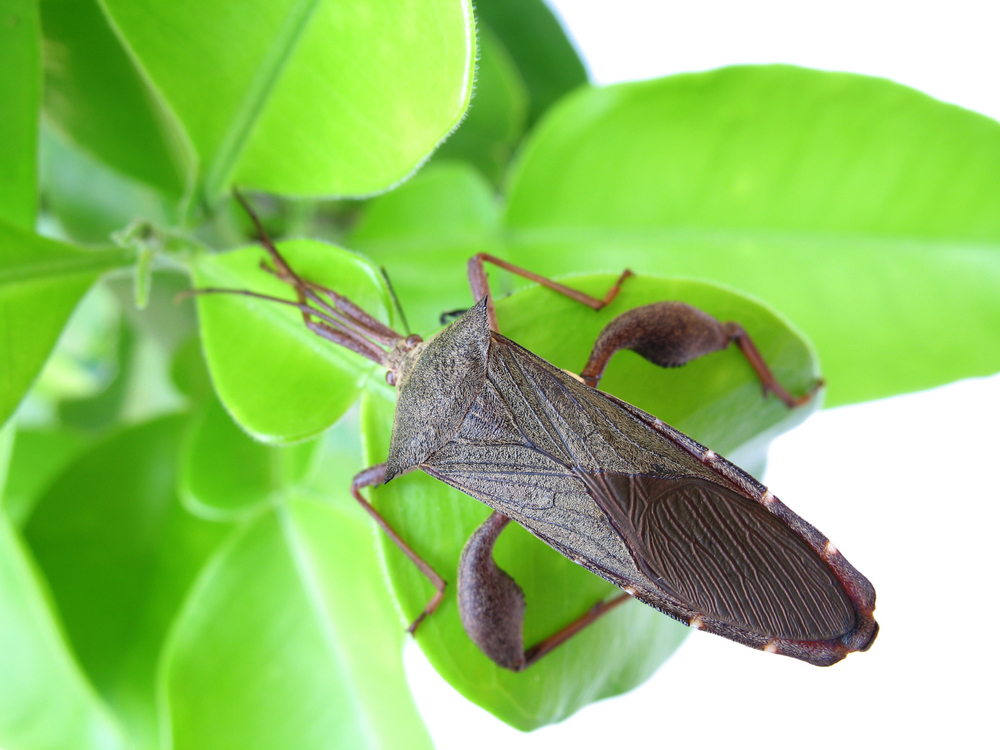Report: Stink Bugs, 6 More Fall Invaders That Could Enter Your Home
When last we checked on them, a brigade of insects led by the odoriferous brown marmorated stink bug were heading out of your house to fill their tracheae with a fresh breath of air. They fled as fast as their many legs and wings would carry them and, now that the days are growing shorter and cooler, they're just itching to set up winter camp in your nice, cozy home.
Sealing every last crevice in the foundation and around windows and doors will at least slow down the dread stink bugs and six other types of insects crawling into your house right now.
Stink bugs have piercing, sucking mouthparts — which they curiously tuck between their legs when they're not piercing and sucking the juice out of plants — but as scary as that sounds, they can't use their needle-like mouths to bite you. And they can't sting. It's just not their thing. But pee-yew, do they smell if you smash them, hence their name. So don't do that.
If you can't make your house a fortress against stink bugs and their pals, the thing to do if you find them inside is gently sweep them into a bucket, then fill it with a couple of inches of soapy water. Or, you can add soapy water to a shop vacuum canister and then suck them up, which doesn't sound like nearly as much fun for the stink bug as the lethal bubble bath.
Or, if you can bear the thought of living communely with them inside the same walls, you could just leave them alone and hope no one frightens them and stirs up a stinky ruckus. They don't nest or lay eggs. They don't don't feed on anything or anyone in your house. They're just there taking a load off for a few months, resting up.
Even though they're harmless to you, they're quite destructive when it comes to other living things. In less than 20 years, these insects indigenous to East Asia have made their way into 44 states. Land-grant university extension services have developed SWAT teams to track their spread across the country. It's all-out war, with good reason. What they can do to an apple orchard isn't pretty and can wipe out a grower's entire crop.
Here are six other insects making their fall invasions, along with tips on what to do:
Another Stinker: Asian Lady Beetles
Stink bugs aren't the only fall invaders that will offend your olfactory senses. When handled roughly, the multi-colored Asian lady beetle can ooze a foul-smelling orange liquid from its leg joints.
Asian lady beetles hitchhiked their way to the United States, too. They're also very hungry, and serve a beneficial role as natural predator of many other pests, especially aphids, these voracious eaters' favorite.
Gardeners appreciate them for that, and they're generally harmless to people and pets. They're positively poetic and, admit it, at some point you've called some girl child "Lady Bug." But don't be beguiled because they're cute.
These tiny beetles are titanic troublemakers when enough of them get in your house. They crawl about on windows and walls and in attics. Say you're having a dinner party when the bug decide to go out on safari. Your friends will notice and start scratching. And then the beetles will do that stinky thing with their legs, leave a yellow stain on whatever they land — hopefully not someone's dinner napkin — and then die. Ew. Your guests will flee.
What to do: It's best to get rid of Asian lady beetles before that happens. Because they can be beneficial, this can be tricky. First, know for sure what kind of beetle you're dealing with. They come in a variety of colors from pale tan to a brilliant red-orange and can have no spots, many spots, or large or small spots. The black and white markings directly behind the head identify Asian lady beetles.
Ahead of their invasions, they'll swarm to the sunlit sides of buildings, as if they're convening to plot their coup d'etat on your home. An insecticide approved for outdoor use will take care of them, plus you'll want to extend your caulking from doors, window and foundations to wherever a pipe, conduit, telephone or cable TV wire goes through the siding. Check attic windows and repair if necessary, and make sure the weather seal on basement windows is tight.
Despite your best efforts, they can get inside your house. You can control them with an indoor insecticide product, but that isn't recommended. If they're flying and crawling about inside, it's cold outside, and if it's cold outside, your furnace is running, recirculating the insecticide in your home. A better plan is to suck them up with a hand-held or other vacuum with a bag that can be emptied.
A Stink Bug Look-Alike That May Bite
If you sealed up all the cracks and crevices to keep the Asian lady beetles out, you should be good to go in your battle against western conifer seed bugs — unless you have loosely hung vinyl siding, and then no amount of caulking is going to deter them.
You're likely to find these bugs in areas with evergreen trees old enough to produce cones, because they like to feed on the gooey goodness inside of the conifer seeds. They closely resemble stink bugs but have wider hind legs.
Western conifer seed bugs also have — here's that chilling phrase again — piercing, sucking mouthparts, but unlike brown marmorated stink bugs, are at least anatomically able to bite humans. It was probably an accident or a fluke, but a person in Budapest, Hungary, who was bitten by a conifer seed bug had a fairly painful irritation and lesion that lasted 48 hours. The area the bug chomped remained red for about a month.
Still, think of western conifer seed bugs' invasion into your heated home the same way you'd look at a free Caribbean vacation in the numbing cold of January. There's no way you're not going to take it — even though you could survive without it. These bugs could simply go dormant in their hiding places behind siding and in attics and you'd never see them, but they think your heated home is Jamaica.
What to do: Deal with it? Once they're inside walls, there's not much you can do. It's likely you'll continue to see them throughout the winter. Insecticides approved for indoor use can be expensive, and it's nearly impossible to treat every surface. These bugs are lethargic, so you should be able to vacuum them up.
Boxelder Bugs (No, They Don't Vote)
Did you know that in some parts of the country, boxelder bugs are known as Democrat bugs, a term of denigration? Just a little trivia. Boxelder bugs sure are pretty, though. They're dark gray or black, and their red-edged wings form a V-shape in the middle of their backs. They are found wherever boxelder trees are nearby, and in the fall, they look for dry, protected sites, including attics and wall cavities, to spend the winter.
They're harmless. They don't chew on you, your food or your clothes. They don't lay eggs. Like the western conifer seed bugs, they just hang out in your home like they're vacationing in the tropics.
What to do: Your best weapon of defense is a caulking gun here, too. Once they're in, even aggressive and costly insecticide applications may not be effective because it is nearly impossible to treat every hidden area that may be harboring insects. Sealing cracks around electrical outlet boxes, switches and light fixtures, and around window and baseboard molding on the inside walls will help keep the bugs trapped within the walls.
In older homes with double-hung windows equipped with pulleys, insects commonly enter living areas through the pulley opening. Masking tape applied over the opening will keep insects from entering through this route. Vacuuming up the sluggish, slow moving bugs works, too.
Nasty Cluster Flies
Cluster flies look a lot like the common house fly, but have a patch of yellow hairs under their wings. They get in your house by squeezing through cracks around windows and doors, loosely hung siding, soffit vents, louvers and other entry points, and they live up to their name and come into your home in clusters.
If they're in your home, they're likely to remain active throughout the winter months. They're harmless enough. They don't bite. They don't transmit disease. They don't feed or lay eggs during this time.
But they are, after all, flies, and no one wants them buzzing around.
What to do: Get a flyswatter. Indoor aerosol insecticides are effective, too. They're slow movers, so the vacuum cleaner is also an effective weapon. Winterization maintenance actions like those advised for other fall invaders can help keep them out, but once they're in, they're in. Chill.
Click here to continue.







